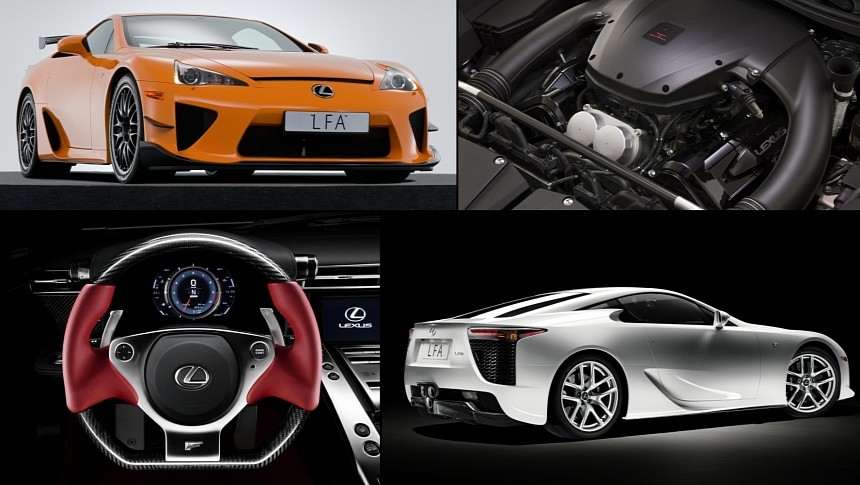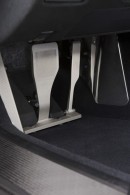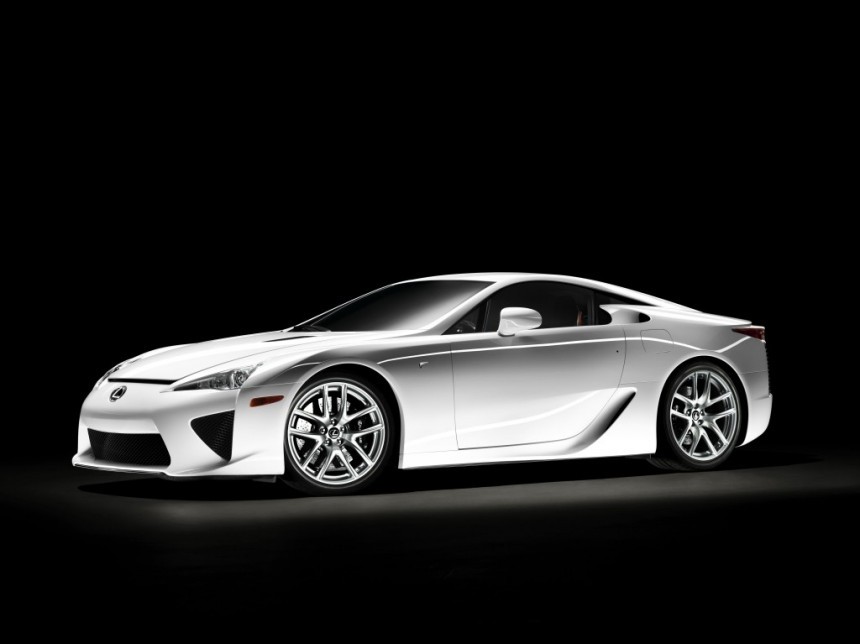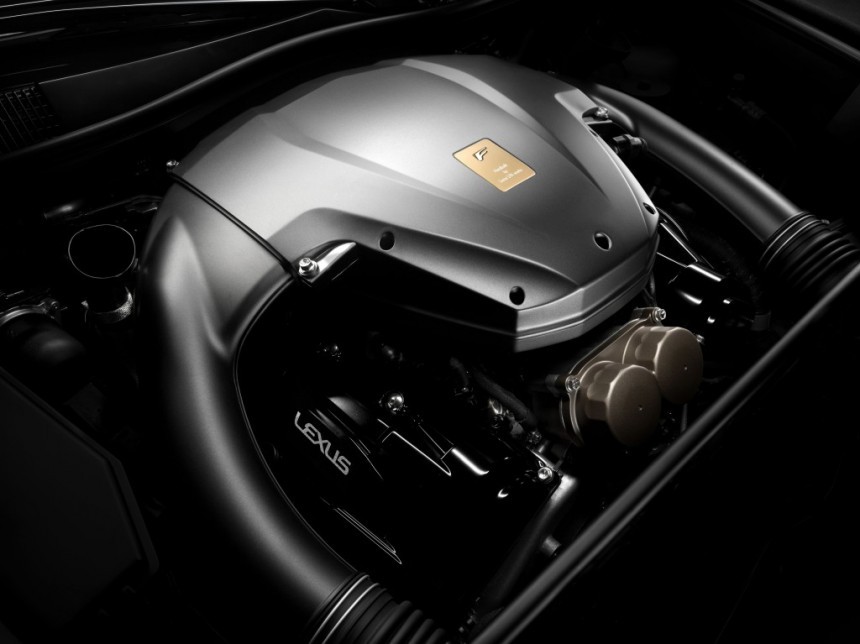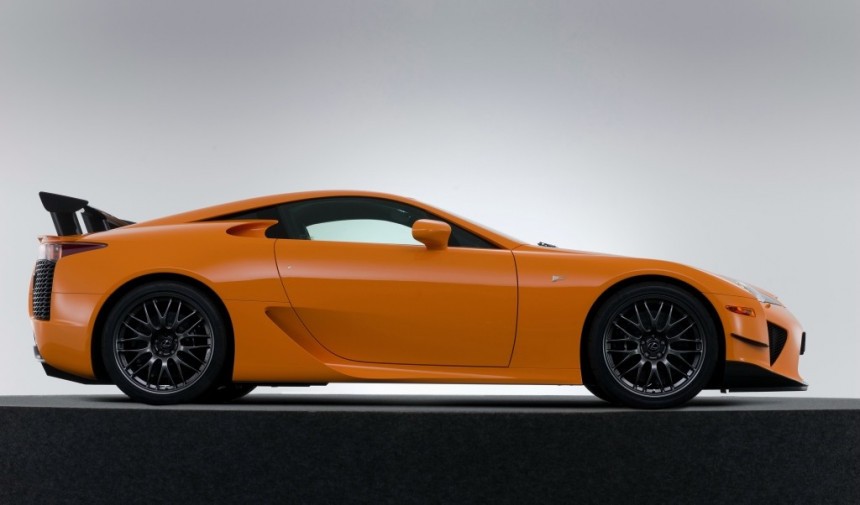Early in the 1980s, the Toyota Motor Corporation started the F1 project. The Japanese manufacturer painstakingly developed the LS over a period of six years at the cost of more than $1 billion – huge money back then – with one purpose in mind: to beat Mercedes and BMW at their own game. Rather surprisingly, Lexus did exactly that with the first-gen LS.
The no-expenses-spared development process ensured the commercial success of the Luxury Sedan through engineering excellence and world-class reliability, but also elevated the Lexus brand to a household name overnight. The aforementioned $1 billion research & development budget caused a few executives to sweat nervously with unease, yet the return on investment exceeded everyone's expectations.
Two decades after the LS went on sale, Lexus rolled out the automaker's first and only supercar thus far. The program is rumored to have cost approximately $800 million, and – as you might already know – each and every single example of the breed was sold at a loss. Each vehicle took about $750,000 to build, way more than the sticker price of $375,000 for the first batch of vehicles produced for the US market.
Whatever the true figures may be, there's no denying that Lexus – with Toyota's blessing – went all in without regard to potential losses. Had it been any other car, the higher-ups may have listened to the bean counters, accepting to fold a losing hand. Why didn't they nip it in the bud, though? Like the V8-powered LS, the V10-engined LFA was a four-wheeled statement. A halo with the odd flaw that anyone expects from a supercar, yet one that improved the luxury brand's sporting image like no other Lexus before or since.
Before digging a little deeper into the LFA, bear in mind that supercar is used for engine configurations other than the midship as well. General Motors, for example, proudly marketed the previous-generation Corvette ZR1 as a supercar. With 755 horsepower and 715 pound-feet (969 Nm) of torque on tap from the only dual-injected small block of the Gen 5 family, it most certainly had what it took to shame mid-engine supercars from that era, both on the road and on the racetrack.
Development of the Lexus Future Apex wasn't as straightforward as that of the LS. The project started in 2000 – merely 11 years after the Luxury Sedan was launched – with a carte blanche. The blank-cheque school of thought spectacularly backfired on Lexus in 2006, when the LFA was approved for production. That's when the people in charge of the project realized that the intended aluminum spaceframe was too heavy and not rigid enough for this application. A carbon-fiber tub was the preferred solution, meaning that many bits of the car had to be redesigned around said tub.
Previewed as the LF-A concept in January 2005 at the North American International Auto Show in Detroit, the production vehicle is powered by a V10 due to Toyota's involvement in Formula 1. Come 2006, the Great Circus started phasing in the 2.4-liter V8. The king of motorized sports switched to the 1.6-liter V6 turbo hybrid unit in 2014, with Mercedes-AMG dominating everyone and everything. Until 2021, that is…
Codenamed 1LR-GUE, the 4.8-liter V10 in the LFA was co-developed with Yamaha Motor Co. What's particularly interesting about this engine is that the Japanese partner's Center for Advanced Sound Technologies had a big say in how this free-breathing mill sounds. Fabulous though it may be, the Lamborghini V10 engine in the Gallardo and Huracan has nothing on this engineering marvel.
Rather than artificially-enhanced induction and exhaust sounds, everything about the 1LR-GUE is natural. The acoustic design approach was based on Yamaha's vast experience in producing high-quality musical instruments. A surge tank integrated into the intake channels the most desirable induction sounds into the cabin by way of sound passages. Even the V10's engine mounts were designed to ensure that no vibrations or mechanical noises spoil the mechanical symphony created by the high-revving lump.
The exhaust system was also tuned for the sake of aural pleasure, with Lexus employing equal-length exhaust manifold runners, a titanium dual-stage rear silencer, and valves actuated by the V10's speed. Above 3,000 revolutions per minute, this motor truly comes alive. Much obliged to hit 9,500 spinnies, this peach of a motor builds up RPMs so quickly that only a digital tachometer can keep up with it.
Tipping the scales at 1,480 kilograms (3,263 pounds), the LFA cranks out 552 horsepower (560 ps) at 8,700 revolutions per minute and 354 pound-feet (480 Nm) at 6,800 revolutions per minute. The Nurburgring performance package, dubbed as such because the LFA was tested on the Green Hell a lot, packs 563 horsepower (570 ps) at similar revs and similar torque.
At $445,000 right off the bat, the Nurburgring specification also boasts superior transmission control unit calibration, stiffer suspension, less ground clearance, better aero, lightweight alloys mounted with Bridgestone Potenza RE070 rubber, and only four exterior colors. Opting for this package also included one to one tuition and a year's pass on the Nordschleife. Only 50 units were intended for production, but 64 were ultimately assembled, making it a very rare sight.
Both the standard LFA and Nurburgring came with an automated manual produced by Toyota subsidiary Aisin. The Motomachi plant ground to a screeching halt in December 2012, with Lexus producing 500 units in total. Just like the Viper, the LFA is one of those so-called zombie cars because Lexus delivered three units in the United States back in 2020, eight years after the Motomachi plant stopped making it.
Two decades after the LS went on sale, Lexus rolled out the automaker's first and only supercar thus far. The program is rumored to have cost approximately $800 million, and – as you might already know – each and every single example of the breed was sold at a loss. Each vehicle took about $750,000 to build, way more than the sticker price of $375,000 for the first batch of vehicles produced for the US market.
Whatever the true figures may be, there's no denying that Lexus – with Toyota's blessing – went all in without regard to potential losses. Had it been any other car, the higher-ups may have listened to the bean counters, accepting to fold a losing hand. Why didn't they nip it in the bud, though? Like the V8-powered LS, the V10-engined LFA was a four-wheeled statement. A halo with the odd flaw that anyone expects from a supercar, yet one that improved the luxury brand's sporting image like no other Lexus before or since.
Before digging a little deeper into the LFA, bear in mind that supercar is used for engine configurations other than the midship as well. General Motors, for example, proudly marketed the previous-generation Corvette ZR1 as a supercar. With 755 horsepower and 715 pound-feet (969 Nm) of torque on tap from the only dual-injected small block of the Gen 5 family, it most certainly had what it took to shame mid-engine supercars from that era, both on the road and on the racetrack.
Development of the Lexus Future Apex wasn't as straightforward as that of the LS. The project started in 2000 – merely 11 years after the Luxury Sedan was launched – with a carte blanche. The blank-cheque school of thought spectacularly backfired on Lexus in 2006, when the LFA was approved for production. That's when the people in charge of the project realized that the intended aluminum spaceframe was too heavy and not rigid enough for this application. A carbon-fiber tub was the preferred solution, meaning that many bits of the car had to be redesigned around said tub.
Previewed as the LF-A concept in January 2005 at the North American International Auto Show in Detroit, the production vehicle is powered by a V10 due to Toyota's involvement in Formula 1. Come 2006, the Great Circus started phasing in the 2.4-liter V8. The king of motorized sports switched to the 1.6-liter V6 turbo hybrid unit in 2014, with Mercedes-AMG dominating everyone and everything. Until 2021, that is…
Codenamed 1LR-GUE, the 4.8-liter V10 in the LFA was co-developed with Yamaha Motor Co. What's particularly interesting about this engine is that the Japanese partner's Center for Advanced Sound Technologies had a big say in how this free-breathing mill sounds. Fabulous though it may be, the Lamborghini V10 engine in the Gallardo and Huracan has nothing on this engineering marvel.
Rather than artificially-enhanced induction and exhaust sounds, everything about the 1LR-GUE is natural. The acoustic design approach was based on Yamaha's vast experience in producing high-quality musical instruments. A surge tank integrated into the intake channels the most desirable induction sounds into the cabin by way of sound passages. Even the V10's engine mounts were designed to ensure that no vibrations or mechanical noises spoil the mechanical symphony created by the high-revving lump.
The exhaust system was also tuned for the sake of aural pleasure, with Lexus employing equal-length exhaust manifold runners, a titanium dual-stage rear silencer, and valves actuated by the V10's speed. Above 3,000 revolutions per minute, this motor truly comes alive. Much obliged to hit 9,500 spinnies, this peach of a motor builds up RPMs so quickly that only a digital tachometer can keep up with it.
Tipping the scales at 1,480 kilograms (3,263 pounds), the LFA cranks out 552 horsepower (560 ps) at 8,700 revolutions per minute and 354 pound-feet (480 Nm) at 6,800 revolutions per minute. The Nurburgring performance package, dubbed as such because the LFA was tested on the Green Hell a lot, packs 563 horsepower (570 ps) at similar revs and similar torque.
At $445,000 right off the bat, the Nurburgring specification also boasts superior transmission control unit calibration, stiffer suspension, less ground clearance, better aero, lightweight alloys mounted with Bridgestone Potenza RE070 rubber, and only four exterior colors. Opting for this package also included one to one tuition and a year's pass on the Nordschleife. Only 50 units were intended for production, but 64 were ultimately assembled, making it a very rare sight.
Both the standard LFA and Nurburgring came with an automated manual produced by Toyota subsidiary Aisin. The Motomachi plant ground to a screeching halt in December 2012, with Lexus producing 500 units in total. Just like the Viper, the LFA is one of those so-called zombie cars because Lexus delivered three units in the United States back in 2020, eight years after the Motomachi plant stopped making it.
